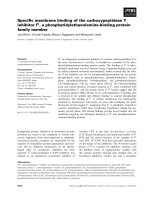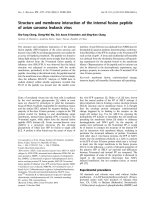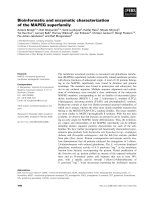Báo cáo khoa học: "Glycogen-rich clear cell carcinoma of the breast" pps
Bạn đang xem bản rút gọn của tài liệu. Xem và tải ngay bản đầy đủ của tài liệu tại đây (330.84 KB, 4 trang )
BioMed Central
Page 1 of 4
(page number not for citation purposes)
World Journal of Surgical Oncology
Open Access
Case report
Glycogen-rich clear cell carcinoma of the breast
Christos Markopoulos*, Dimitris Mantas, T Philipidis, Efstatios Kouskos,
Zoi Antonopoulou, ML Hatzinikolaou and Helen Gogas
Address: Breast Unit, 2nd Propedeutic Department of Surgery, Athens University Medical School, Greece
Email: Christos Markopoulos* - ; Dimitris Mantas - ; T Philipidis - ;
Efstatios Kouskos - ; Zoi Antonopoulou - ; ML Hatzinikolaou - ;
Helen Gogas -
* Corresponding author
Abstract
Background: Glycogen-rich carcinoma of the breast is a rare histological subtype of breast
cancer, usually reported to have poor prognosis.
Case presentation: We present the case of a 59-year-old woman who underwent a mastectomy
for a 3.5 cm clinically palpable left breast carcinoma, originally diagnosed as fibroadenoma on a
screening mammogram four years before presentation. Diagnosis of clear cell carcinoma was based
on certain histological characteristics of the tumour and immunohistochemical analysis (PAS
staining, keratins AE1/AE3, EMA, cytokeratin 7, cytokeratin 20, melanosomes, vimentin,
Chromogranin, Synaptophysin, S-100, SMA). No lymph node metastasis was found and as the
tumour was ER positive and PgR negative, patient was treated only with an aromatase inhibitor
upfront and remains free of disease 48 months now since operation.
Conclusion: Glycogen-rich clear cell carcinoma of the breast is a rare tumor, its clinical behavior
reported to be rather aggressive so far, might varies depending on special characteristics such as
low grade and strongly positive ER expression
Background
Glycogen-rich clear cell carcinoma is a rare neoplasm of
the breast, with an incidence of between 1.4% and 3% of
all breast cancers [1,2]. The tumour has distinct morphol-
ogy, different from that of common breast cancers. It
shares common characteristics with clear cell carcinomas
of the lung, endometrium, cervix, ovary, kidneys and sali-
vary glands [3]. Glycogen-rich clear cell carcinomas are
members of a heterogeneous group of neoplasms, includ-
ing signet-ring, secretory and lipid-rich carcinomas of the
breast [4]. In general, clear cell breast carcinoma tends to
follow an aggressive clinical course [5]. However, we
report the case of a 59-year-old woman with a slow grow-
ing tumour of her left breast, originally considered as
fibroadenoma, but which proved to be a 3.5 cm glycogen-
rich clear cell carcinoma without lymph node involve-
ment, four years later.
Case presentation
A 59-year-old Caucasian woman presented with a breast
mass in the upper outer quadrant of her left breast. She
noticed the lump on self-examination a few months
before presenting to our out-patient clinic. The lesion was
mobile, with no evidence of dermal invasion and axillary
lymph nodes were not palpable. A 3.5 cm lobulated, cir-
cumscribed mass was shown on her recent mammogram,
Published: 29 April 2008
World Journal of Surgical Oncology 2008, 6:44 doi:10.1186/1477-7819-6-44
Received: 26 November 2007
Accepted: 29 April 2008
This article is available from: />© 2008 Markopoulos et al; licensee BioMed Central Ltd.
This is an Open Access article distributed under the terms of the Creative Commons Attribution License ( />),
which permits unrestricted use, distribution, and reproduction in any medium, provided the original work is properly cited.
World Journal of Surgical Oncology 2008, 6:44 />Page 2 of 4
(page number not for citation purposes)
suggestive of a fibroadenoma, with no evidence of malig-
nancy (Figure 1). Ultrasound scanning showed a solid,
hypoechoic and well-circumscribed mass, measuring 3.5
cm in diameter. However, elevated Ca 15-3 levels were
found in blood tests she already had.
The same lesion, less than half in size, was originally
shown on the first mammogram she had at her home-
town four years before. It was not clinically palpable that
time and it was thought to be a long existing benign
fibroadenoma and was left in place.
She had full staging investigations (liver function tests,
chest x-ray, computerized tomography scans of the chest
and abdomen and bone scanning) which were all nega-
tive and the patient underwent an excisional biopsy,
which revealed an invasive carcinoma. A left modified
radical mastectomy followed.
Pathological findings
On macroscopic examination the tumour measured 3.5
cm in diameter, had solid composition and polymorphic
appearance, with tan and brown, pale and hemorrhagic
areas.
Microscopic examination showed an invasive adenocarci-
noma of the breast, characterized by average-sized cells,
with well-defined borders and polygonal, rather than
rounded contours. The neoplastic cells formed a matrix of
solid, lobular, acinar and rarely papillary areas, with a fine
vascular network in between (Figure 2). Foci of linear,
trabecular and tubular growth patterns were visible. A few
ducts with an intraductal (in situ) carcinoma of solid type
were also noticed. The cytoplasm was clear and eccentri-
cally placed and hyperchromatic nuclei with a low mitotic
number (2 mitoses per 10HPF) were detected. Cells with
mildly eosinophilic cytoplasma, nuclear pleomorphism
and higher mitotic number were also seen. There was
Clear-cell carcinoma of the breast, resembling clear-cell car-cinoma of the kidneyFigure 2
Clear-cell carcinoma of the breast, resembling clear-cell car-
cinoma of the kidney. The lobular arrangement and the fine
vascular network are clearly visible.
Left breast mammogram showing a lobulated, circumscribed mass with no evidence of malignancy, suggestive of a fibroad-enomaFigure 1
Left breast mammogram showing a lobulated, circumscribed
mass with no evidence of malignancy, suggestive of a fibroad-
enoma.
World Journal of Surgical Oncology 2008, 6:44 />Page 3 of 4
(page number not for citation purposes)
absence of necrosis and no lymphovascular invasion was
noticed.
On histochemical examination, many of the above cells
were positive for PAS staining erased by diastase pre-treat-
ment, keratins AE1/AE3, EMA and Cytokeratin 7, but neg-
ative for c-erb-b2 (score 0), Cytokeratin 20, melanosomes
and vimentin. Markers of myoepithelial cells were also
negative: smooth muscle actin-SMA and S-100 (only a few
isolated positive cells). Staining for Chromogranin was
positive in some cells and for Synaptophysin in most cells,
indicating a degree of neuroendocrine activity of the
tumor. The tumor was strongly positive for estrogen
receptors (ER) and negative for progesterone receptors
(PgR).
Mastectomy specimen showed no residual neoplastic
cells, and all 14 axillary lymph nodes removed were histo-
logically tumor-free.
Hormonal therapy with the aromatase inactivator
exemestane was started postoperatively and the patient is
disease-free 48 months now.
Discussion
Glycogen-rich clear cell carcinoma of the breast is a rare
tumor. It is, however, the most frequent cause of clear cell
morphology in breast malignancies [5]. It is composed of
cells containing abundant glycogen, which is extracted
when the tissue is processed for histological sections, leav-
ing vacuolated cytoplasm. Extraction of the cytoplasmic
components also occurs in lipid-rich carcinoma, signet-
ring cell carcinoma and in some secretory variants of duc-
tal or lobular carcinomas, as well as sebaceous, myoepi-
thelial and endocrine tumours [5]. Cells with clear,
vacuolated cytoplasm have been rarely found in benign
breast lesions, such as clear cell hindradenoma, eccrine
spiradenoma, acrospiroma and benign mammary myoep-
ithelioma [4]. These are only known as isolated case
reports.
Signet-ring carcinomas frequently coexist with ductal or
lobular carcinomas and display an aggressive course with
frequent lymph node and distant metastases [6]. Lipid-
rich carcinomas tend to occur in elderly women as pure
lesions, often involving axillary lymph nodes and have
been occasionally reported to metastasize to the eyelid
[7]. Secretory carcinomas frequently arise in young
women, but rarely metastasize to axillary lymph nodes
[8].
Clear cell neoplasms arise throughout the body. The vac-
uolated cytoplasm in many of these tumors can be attrib-
uted to large quantities of glycogen, as in clear cell
carcinomas of the vagina, cervix, endometrium, ovary and
salivary glands. The clear cell in renal adenocarcinoma
contains not only glycogen, but abundant fat, both of
which contribute to their optically clear quality [9]. In the
lung, two clear cell tumors are known: the benign clear
cell (sugar) tumor, which contains abundant glycogen
[10,11] and the clear carcinoma, which contains abun-
dant mucin [12]. Clear cell carcinoma of the larynx, a var-
iant of mucoepidermoid carcinoma, gains its clear cell
features from both intracytoplasmic glycogen and mucin
[13]. In the thyroid, some clear cell carcinomas contain
abundant colloid material [14], while others contain
abundant glycogen [15]. Thus, the subcellular determi-
nants of the clear cytoplasm vary from case to case.
Fewer than fifty cases of glycogen-rich clear cell carcinoma
of the breast have been described since the first case was
reported in 1981 [3]. The patients, aging from 35 to 78
years, presented with a mass that was sometimes accom-
panied by skin dimpling, nipple retraction or pain. Most
tumours reported measure between 2 and 5 cm in diame-
ter, with the largest lesion found to be 10 cm on clinical
examination [3]. Hormone receptor analysis revealed that
about 50% of the tumors were estrogen receptor positive,
but all lesions studied, including our patient, have been
negative for progesterone receptor. When analysed by
flow cytometry, the tumors have been nondiploid [2].
Almost all patients were treated with mastectomy and
axillary dissection and more than half had metastatic
tumour in the axillary lymph nodes [3]. Our patient
found to have negative axilla, despite the large size of the
primary tumour.
The prognosis of glycogen-rich clear cell carcinoma of the
breast is reported to be not particularly favorable and may
be similar to or worse than that of ordinary invasive ductal
carcinoma, when compared on a stage-matched basis [5].
However, in the case reported here, the patient had a his-
tory of at least 4 years with a slow growing clear cell carci-
noma of her breast. The tumour had benign features on
mammography and the well circumscribed appearance
was suggestive of fibroadenoma. No axillary lymph node
involvement was found and there was no evidence of sys-
temic disease in staging investigations. The only patho-
logic finding before surgical treatment was elevated levels
of Ca 15-3, which dropped to normal following opera-
tion. Our patient, staged T2N0M0, is free of disease 48
months now and continues adjuvant therapy with an aro-
matase inhibitor only.
Conclusion
Glycogen-rich clear cell carcinoma of the breast is a rare
tumor, its clinical behavior reported to be rather aggres-
sive so far, might varies depending on special characteris-
Publish with BioMed Central and every
scientist can read your work free of charge
"BioMed Central will be the most significant development for
disseminating the results of biomedical research in our lifetime."
Sir Paul Nurse, Cancer Research UK
Your research papers will be:
available free of charge to the entire biomedical community
peer reviewed and published immediately upon acceptance
cited in PubMed and archived on PubMed Central
yours — you keep the copyright
Submit your manuscript here:
/>BioMedcentral
World Journal of Surgical Oncology 2008, 6:44 />Page 4 of 4
(page number not for citation purposes)
tics such as low grade and strongly positive ER expression
as in the case of our patient.
Competing interests
The authors declare that they have no competing interests.
Authors' contributions
CM: drafting and revision of the manuscript, DM: Helped
in preparation and revision of the manuscript, TP: revi-
sion of the manuscript and preparation of histology and
immunoassays, EK: Surgery and follow-up and helped in
revision of the manuscript; ZA: surgery and follow-up of
patient and helped in preparation of the manuscript,
MLH: editing of the manuscript for its scientific content,
EG: surgery of the patient and revision of the manuscript
for its scientific content. All authors read and approved
the final manuscript.
Acknowledgements
The written consent was obtained from the patient for publication of this
case report.
References
1. Tavassoli FA: Infiltrating carcinoma: special types. In Pathology
of the breast 2nd edition. Stanford Connecticut: Appleton & Lange;
1990:481-570.
2. Toikkanen S, Juensuu H: Glycogen rich clear cell carcinoma of
the breast: a clinicopathologic and flow cytometric study.
Hum Pathol 1991, 22(1):81-83.
3. Rosen PP: Glycogen-rich carcinoma. Rosen's Breast Pathology. Lip-
pincot-Raven 2001:557-559.
4. Hull MT, Priest JB, Broadie TA, Ransburg RC, McCarthy LJ: Glyco-
gen-rich clear cell carcinoma of the breast: a light and elec-
tron microscopic study. Cancer 1981, 48:2003-2009.
5. Hayes MMM, Seidman JD, Asthon MA: Glycogen rich clear cell
carcinoma of the breast. A clnicopathologic study of 21
cases. Am J Surg Pathol 1995, 19:904-911.
6. Hull MT, Seo I, Battersby JS: Signet-ring cell carcinoma of the
breast: a clinicopathologic study of 24 cases. Am J Clin Pathol
1980, 73:31-35.
7. Hood CI, Font RL, Zimmerman LE: Metastatic mammary carci-
noma in the eyelid with histiocytoid appearance. Cancer 1973,
31:793-800.
8. Sullivan JJ, Magee HR, Donald KJ: Secretory (juvenile) carcinoma
of the breast. Pathology 1977, 9:431-346.
9. Bennington JL, Beckwith JB: Tumors of the Kidney, Renal Pelvis,
and Ureter. In Atlas of tumour Patology, Second Series, Fasicle 12
Washington, DC: Armed Forces Institute of Pathology; 1975:150.
10. Liebow AA, Castleman B: Benign clear cell ("sugar") tumors of
the lung. Yale J Biol Med 1971, 43:213-222.
11. Sale GF, Kulander BG: Benign clear cell tumor of lung with
necrosis. Cancer 1976, 37:2355-2358.
12. Morgan AD, Mackenzie DH: Clear-cell carcinoma of the lung. J
Pathol Bact 1964, 87:25-27.
13. Seo I, Tomich CE, Hull MT, Warfel KA: Clear cell carcinoma of
the larynx: a variant of mucoepidermoid carcinoma. Ann Otol
Rhinol Laryngol 1980, 89:168-172.
14. Variakojis D, Getz ML, Paloyan E, Straus FH: Papillary clear cell
carcinoma of thyroid gland. Hum Pathol 1975, 6:384-390.
15. Valenta LJ, Michel-Bechet M: Electron microscopy of clear cell
thyroid carcinoma. Arch Pathol Lab Med 1977, 101:140-144.









